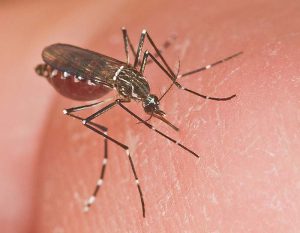- A University of Florida study has shed light on a mosquito mystery that had residents of a California county at odds with the efforts of the local operational mosquito control district.
- The public pushback was over an aggressive education campaign and mosquito control treatment program that was launched upon the detection of the invasive mosquito species Aedes aegypti, commonly known as the yellow fever mosquito.
- Scientists at UF’s Institute of Food and Agricultural Sciences (UF/IFAS) used a DNA-sequencing tool that made several advances including getting a closer look at a species reportedly eliminated from a city and determining why it later reintroduced.
 VERO BEACH, Fla. — The invasive Aedes aegypti mosquito species is a source of frustration for pest management professionals and mosquito control districts because it is exceptionally difficult to control.
VERO BEACH, Fla. — The invasive Aedes aegypti mosquito species is a source of frustration for pest management professionals and mosquito control districts because it is exceptionally difficult to control.
This same mosquito species is also responsible for infecting more than 400 million people worldwide each year with viruses such as dengue, yellow fever, chikungunya and Zika.
In the published study, “Evidence of local extinction and reintroduction of Aedes aegypti in Exeter, California,” scientists at the UF/IFAS Florida Medical Entomology Laboratory (UF/IFAS FMEL) solve a mystery by conducting a detailed population genomic analysis. This tool, which scientists expect will help detect the movement and spread of the species, is a large-scale comparison of DNA sequencing of species populations.
“Longitudinal genomic-based investigations like this help us learn more about organism population dynamics and species interactions,” said Yoosook Lee, an assistant professor of molecular ecology at UF/IFAS FMEL. “This will aid us in the future questions we may think of that demand comparing samples collected over several years.”
One of the key takeaways of the study’s findings is that it validated the 2014 mosquito control efforts in Exeter, California. The Delta Vector Control District (DVCD) managed to achieve that year a reported elimination of a cluster of yellow fever mosquitoes, but after the species was detected again in 2018, the public questioned the effectiveness of the first effort.
“We had a unique opportunity to investigate the 2018 Exeter samples to test if the population went through severe bottleneck and recovered, or if the DVCD successfully eliminated it in 2014 and then was reintroduced from neighboring locations,” Lee said.
For the study, published in Frontiers in Tropical Diseases, the scientists used detailed population genomic analyses to take a close look at the species local population’s genomic characteristics of the yellow fever mosquito that invaded. Using this tool eventually helped to determine the effectiveness of the 2014 operational mosquito control efforts.
In this case, Lee and her team were able to discover multiple genetically distinct populations of the species in surrounding areas. The 2014 Exeter samples were genetically similar to samples from Vero Beach, Florida. The 2018 Exeter samples were different from 2014 Exeter samples and closely resemble the genetic signature of southern California clusters. The process also found distinct genetic differences in those sampled from surrounding communities and those in Florida.
“This is a particularly important development because some residents were resistant to mosquito control measures after the re-emergence of Aedes aegypti in their neighborhoods. It seemingly proved that the mosquito control district’s intensive control efforts to curb spread of this potentially deadly, invasive mosquito were unnecessary and ineffective,” she said.
To curb the species spread in a community, mosquito control districts and science encourage early detection combined with an integrated approach and a coordinated effort with the public. Sometimes those efforts create friction between communities and mosquito control professionals.
“This work indicates that local elimination of dengue- and Zika-transmitting mosquito Aedes aegypti in a suburban environment is possible, but elimination requires considerable effort and resources to do using an integrated vector control approach,” Lee said.
A population genomics approach can serve as a tool to detect population movements of the mosquito species and determine if treatments are successful in the geographic areas where treatments were conducted, Lee added.
“Our story supports the Delta Mosquito Control District’s decision and successful execution of local elimination effort,” Lee said. “But it also illuminated the challenges the other neighboring districts in their effort to control the Aedes aegypti mosquito spread due to extremely high levels of insecticide resistance in their invaded mosquito populations.”
By: Lourdes Mederos, rodriguezl@ufl.edu
The mission of the University of Florida Institute of Food and Agricultural Sciences (UF/IFAS) is to develop knowledge relevant to agricultural, human and natural resources and to make that knowledge available to sustain and enhance the quality of human life. With more than a dozen research facilities, 67 county Extension offices, and award-winning students and faculty in the UF College of Agricultural and Life Sciences, UF/IFAS brings science-based solutions to the state’s agricultural and natural resources industries, and all Florida residents.
ifas.ufl.edu | @UF_IFAS
 0
0
